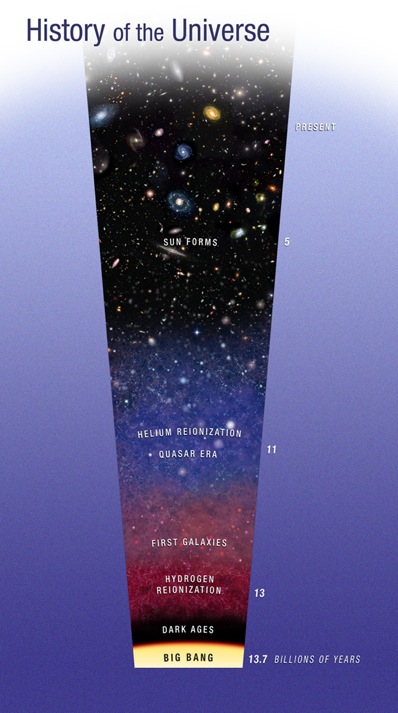
Early heatwave stunts
dwarf galaxy growth
by Nicky Guttridge
for ASTRONOMY NOW
Posted: 11 October 2010


Measurements using NASA’s Hubble Space Telescope have shown that the growth of early galaxies was stunted early in their formation by fierce radiation blasts from active galaxies and quasars.
The measurements were obtained using Hubble’s new Cosmic Origins Spectrograph (COS) and suggest that quasars were the source for early intense blasts of radiation that persisted for approximately 500 million years, causing a period of stunted growth for some dwarf galaxies.

A diagram tracing the evolution of the Universe from past to present, showing the eras of hydrogen and helium reionization. Image: NASA, ESA, and A. Feild (STScI).
The research team dated the age of this spate of strong radiation and associated phase of universal warming to 11.7 to 11.3 billion years ago. During this era, ultraviolet light emitted by active galaxies stripped electrons off the interstellar helium atoms in a process known as ionization. This process heated the intergalactic helium from nearly 10,000 degrees Celsius to around 22,000 degrees. These high temperatures meant that the gas could not gravitationally collapse to create regions of star formation, resulting in many small galaxies having stunted growth.
The COS has improved sensitivity and lower background noise than previous space-based spectrographs, allowing very detailed observations of the intergalactic medium and interstellar hydrogen present there. “These COS results yield new insight into an important phase in the history of our Universe,” says Hubble Program Scientist Eric Smith at NASA Headquarters in Washington. The research team, led by Michael Shull of the University of Colorado, analysed the spectrum of ultraviolet light produced by quasars and found traces of ionized helium. Studying the light emitted by quasars was a key part of the team’s research, as such signals travel through large clouds of intergalactic material before reaching our galactic neighbourhood. Analysis of the resulting spectrum allows for an accurate compositional representation of the intergalactic material itself.
More than 13 billion years ago, early massive stars were the sources of energy capable of ionizing the cold interstellar hydrogen left after the big bang. The time of this interstellar heat wave is known as reionization, due to the fact that shortly after the big bang the nuclei of interstellar hydrogen were in an ionized state.
Primordial helium was also formed during the big bang, and Schull and his colleagues found that it would take another two billion years before the Universe formed sources of ultraviolet energy powerful enough to reionize this population. These sources were no longer massive stars but supermassive black holes, which are found at the core of active galaxies. During this period of interstellar warming they were capable of turning vast amounts of gravitational energy – corresponding to their large mass – into ultraviolet radiation that subsequently streamed out of active galaxies.
After the interstellar helium population was reionized, intergalactic gas cooled again, meaning that dwarf galaxies were capable of growth through star formation. “I imagine quite a few more dwarf galaxies may have formed if helium reionization had not taken place,” says Shull.
The team’s results will be published in the 10 October issue of The Astrophysical Journal. The COS science team plan to further their research in a bid to find out if this helium reionization took place uniformly across the Universe.
|



